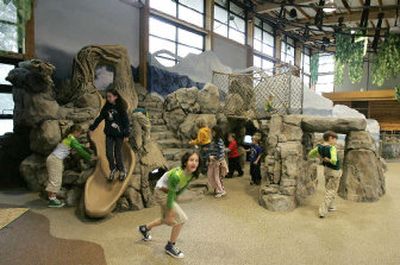A need to play

These are hard times for child’s play:
“Testing pressures have squeezed much of the play out of kindergarten, according to many activists and researchers. And those pressures are even trickling down to preschools.
“Parents worried about their children’s safety – and maybe hankering for some time to themselves – keep them indoors, often tethered to a television, a computer or a video game.
“And children’s toys – and their fantasy lives – run heavily toward licensed characters derived from videos and television programs created in someone else’s imagination.
All of which is to say: Whatever happened to making mud pies?
Incrementally and almost imperceptibly, “we have completely changed the way children play,” said Dimitri Christakis, a pediatrician and director of the Child Health Institute at the University of Washington. Christakis studies children’s use of media, and he is part of a rising tide of concern about the altered landscape of children’s play. “We’re in the midst of a large, uncontrolled experiment on our children,” he said, “the effects of which we won’t know for years.”
What is known is that the kind of open-ended, hands-on, imaginative and often outdoor play that has been vanishing is critical to young children’s development, said Susan Linn, a psychologist at the Judge Baker Children’s Center, a research, advocacy and clinical unit affiliated with Harvard University. She’s working on a book that she describes as “a celebration of and plea for” imaginative play.
Some of the results of this new era in children’s play are well-documented. Childhood obesity, for example. Others are more anecdotal: children who “don’t know” what to do when left to their own devices. Or who are burned out on school by the fourth grade.
At the same time, preliminary research suggests that a few small efforts across the country are showing the way to put the power back in play. Mobius Kids in downtown Spokane is all about playing, according to executive director Mary Tyrie. The hands-on museum for kids allows children to explore, create and learn by making their own connections with the variety of exhibits, she said.
Children’s play has been extensively studied, and its value is beyond dispute, according to Linn.
“Play is the foundation of critical thinking, the foundation of creativity, the foundation of learning,” she said. “Imaginary play is also a way that children make emotional and social meaning of the world. I think a majority of the country doesn’t know we have a problem, and they’re being sold a bill of goods by policy-makers and the marketing industry.”
A nonprofit organization called the Alliance for Childhood is funding research into the state of play and plans to agitate for the return of play to schools. On its Web site is a “call to action” signed by 260 people, including luminaries such as pediatrician and author T. Berry Brazelton and writer and children’s advocate Jonathan Kozol.
The alliance also is spreading the word about “adventure playgrounds” and play-workers, both ubiquitous in England, and is working with museums to mount exhibits on the now-hot topic of child’s play.
Although children have a natural gift for and drive to play, it can evaporate if not exercised. Several years ago, the alliance surveyed experienced kindergarten teachers in Atlanta about changes in play in their schools over the preceding decade. Several teachers reported that play largely had been eliminated from class and that if they gave children time for play, “they don’t know what to do. They have no ideas of their own.”’
Prevailing playground design doesn’t help much, either.
“It’s usually a bunch of manufactured equipment in an open space devoid of any meaningful vegetation that kids can interact with,” said Randy White, a partner in a Kansas City firm that designs play spaces. “They need chances to hide under bushes and dam up water and build with loose parts. Children want to manipulate their environment.”
White’s firm, White Hutchinson Leisure & Learning Group, tries to persuade clients to provide more engaging play options. That’s finally starting to catch on in the United States, he said.
While anecdotes abound concerning play-challenged children, hard data are scarce. But then, it’s in the nature of the thing, according to Roger Hart, who runs the Children’s Environments Research Center at the City University of New York Graduate Center.
“People haven’t found a way to measure creativity,” he said. “The danger when you get into a hyper-testing environment as we have now is that things … get left behind in the dust, not because they’re not important, but because we don’t know how to measure them.”
Not surprisingly, many of the people worried about the state of children’s play are most distressed about the warping influence of electronic media. And the media’s impact goes beyond the many hours most children spend in front of a screen, Linn said. She pointed out that the year after children’s television was deregulated in the mid-1980s, every one of the best-selling toys was linked to a television program.
“Kids play less creatively with media-linked toys because the character has been defined for them,” said Linn, who wrote a book titled “Consuming Kids” about marketing aimed at children. Toys that come with an identity and a story line mean that “the child doesn’t have to do anything but push a button. It’s not limitless possibilities the way it is when a child picks up a stick.
“It’s funny, isn’t it? It looks like such an advance.”